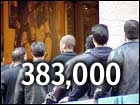Indicators up, trade gap down
Leading indicators rise, trade gap shrinks, jobless claims edge up.
February 21, 2002: 4:06 p.m. ET
|
 NEW YORK (CNN/Money) - A key gauge meant to predict economic activity rose for the fourth straight month in January, while the government reported the nation's trade deficit narrowed last year for the first time in six years.
NEW YORK (CNN/Money) - A key gauge meant to predict economic activity rose for the fourth straight month in January, while the government reported the nation's trade deficit narrowed last year for the first time in six years.
Separately, new claims for jobless benefits rose slightly last week, the government reported, as the labor market in the United States, battered by a recession in the world's largest economy, nevertheless continued to stabilize.
The Labor Department reported that the number of Americans filing new claims for unemployment benefits rose to 383,000 in the week ended Feb. 16, up from 373,000 the preceding week. Economists surveyed by Briefing.com expected 375,000 new claims last week.
"We can get all excited about a thousand [new claims] here or there, but this is stability," Maureen Allyn, chief economist with Zurich Scudder Investments, told CNNfn's Before Hours program. "We're just about at the cusp of that point where we're not either adding or losing jobs."
The four-week moving average of new weekly claims, which smoothes out fluctuations in the weekly data, rose to 381,750 last week from 376,000 in the preceding week.
Separately, the Conference Board, a private research group, said its index of leading economic indicators rose 0.6 percent in January, matching the expectations of analysts surveyed by Briefing.com.
It was the fourth straight increase for the index, led by gains in vendor performance, consumer expectations, average weekly jobless claims and building permits.
"We might be out of recession already," Ken Goldstein, the board's chief economist, told Reuters. "The recovery could be more vigorous than earlier anticipated."
Separately, the Commerce Department reported the U.S. trade deficit shrank to $25.3 billion in December from a revised $28.6 billion in November. Economists surveyed by Briefing.com expected a trade gap of $28.5 billion.
For all of last year, the deficit shrank to $346.3 billion from $375.7 billion in 2000, the first drop since 1995, when the gap edged lower to $96.4 billion, from $96.7 billion the prior year.
Both exports and imports have fallen as a global recession has sapped demand. Exports rose in December to $77.86 billion from $77.74 billion in November, but imports dropped to $103.16 billion from $106.28 billion in November.
On Wall Street, stock prices fell sharply, led lower by technology issues, as investors were unable to build on Wednesday's late gains. Treasury bond prices ended mostly higher.
Click here for CNN/Money's economic calendar
The recession in the United States has led to more than a million job cuts and a rising unemployment rate. Though recent data have indicated that the recession could be near an end, and weekly jobless claims have been below the crucial 400,000 mark for several weeks, the jobless market is still not out of the woods.
Unemployment is a lagging economic indicator, meaning it usually gets worse even as the economy gets better, usually because businesses are reluctant to hire workers until they are assured that the economy and their profits will really recover.
"There's a difference between being stable and starting to grow again," Allyn said. "I think that's what we're hearing from companies, too - the worst may be over, but we really don't see the upside coming, and that's what these jobless claims suggest."
The broadest measure of U.S. economic strength is gross domestic product (GDP), which is affected by imports and exports. The latest data could mean that fourth-quarter GDP will be revised upward when the government next estimates it, since falling imports and rising exports boost GDP.
GDP grew weakly in the fourth quarter after shrinking in the third, the Commerce Department said recently, meaning a recession as commonly defined - two straight quarters of shrinking GDP - might be avoided.
But some economists define a recession differently and say a U.S. recession began last March. And many think that a recovery this year could be weakened by sluggish demand, high levels of consumer debt, concerns about corporate accounting and other headwinds.
"We should see an upward revision to fourth-quarter GDP based on this [trade] number," Allyn said. "But whatever it does to the GDP, it does not suggest that we're starting on a big roar of strength." 
|
|
|
|
|
|

|

